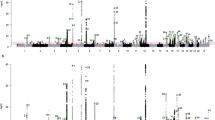Abstract
Information about occurrence of testicular cancer (TC) in relatives of TC patients has been collected using questionnaires from 797 out of 922 consecutive Norwegian and 178 out of 237 Swedish patients with TC seen at the Norwegian Radium Hospital and the University Hospital Lund in Sweden during 1981-91. Fifty-one Norwegian and five Swedish patients had a relative with confirmed TC. Thus, 51/922 (5.5%) of the Norwegian and 5/237 (2.1%) of the Swedish patients treated during the time interval investigated were considered to have familial TC. Thirty-two of the patients had an affected first-degree relative. Expected numbers of cancers in the relatives were computed from data in the Norwegian and Swedish Cancer Registries. Standardised incidence ratios (SIRs) were taken as observed numbers of TC/expected numbers of TC in the relatives. The SIR for brothers was 10.2 (95% confidence interval 6.22-15.77). SIR for fathers was 4.3 (1.6-9.3) and for sons 5.7 (0.7-23.2). The point estimate for the risk to brothers in the Norwegian part of the sample to develop TC by the age of 60 was 4.1% (95% CI 1.7-6.6%). This study indicates that genetic factors may be of greater importance in TC than previously assumed. Patients with familial testicular cancer had bilateral tumours more often than sporadic cases (9.8% bilaterality in familial vs 2.8% in sporadic cases, P=0.02). For patients with seminoma age of onset was lower in familial than in sporadic cases (32.9 vs 37.6 years, P=0.06). In father-son pairs, there was a statistically significant earlier age of diagnosis in the generation of sons (28.8 years vs 44.9 years, P=0.04). The prevalence of undescended testis (UDT) did not seem to be higher in familial than in sporadic TC (8.2% in familial TC and 13.3% in sporadic cases). This may indicate that different factors are of importance for the development of familial TC and UDT.
This is a preview of subscription content, access via your institution
Access options
Subscribe to this journal
Receive 24 print issues and online access
$259.00 per year
only $10.79 per issue
Buy this article
- Purchase on Springer Link
- Instant access to full article PDF
Prices may be subject to local taxes which are calculated during checkout
Similar content being viewed by others
Author information
Authors and Affiliations
Rights and permissions
About this article
Cite this article
Heimdal, K., Olsson, H., Tretli, S. et al. Familial testicular cancer in Norway and southern Sweden. Br J Cancer 73, 964–969 (1996). https://doi.org/10.1038/bjc.1996.173
Issue Date:
DOI: https://doi.org/10.1038/bjc.1996.173
This article is cited by
-
Germ Cell Tumour in Male and Female Siblings: A Case Report and Literature Review
Indian Journal of Gynecologic Oncology (2022)
-
Family history of cancer and risk of paediatric and young adult’s testicular cancer: A Norwegian cohort study
British Journal of Cancer (2019)
-
Family history of cancer in children and adolescents with germ cell tumours: a report from the Children’s Oncology Group
British Journal of Cancer (2018)
-
Close ties: an exploratory Colored Eco-Genetic Relationship Map (CEGRM) study of social connections of men in Familial Testicular Cancer (FTC) families
Hereditary Cancer in Clinical Practice (2012)



